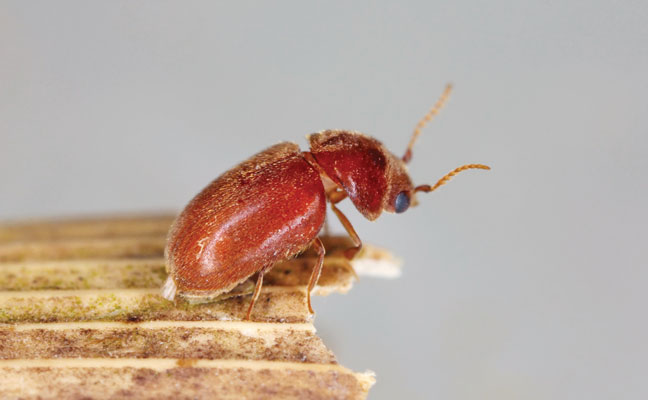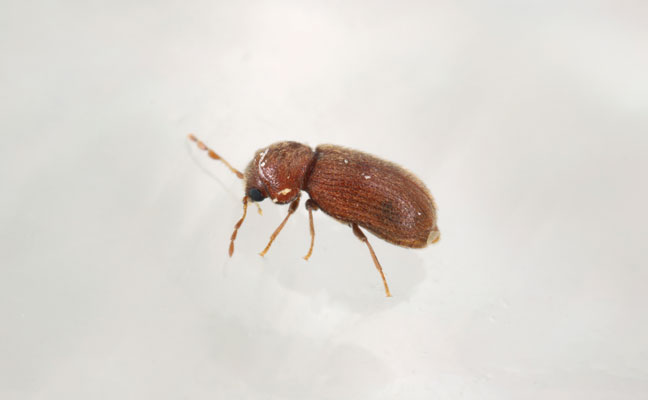
The cigarette beetle is also commonly known as the cigar or tobacco beetle. Photo: Tomasz Klejdysz/iStock / Getty Images Plus/Getty Images
Cigarette beetles (Lasioderma serricorne) and drugstore beetles (Stegobium paniceum) are notorious pests with an ability to infest a wide range of materials, posing significant threats to stored products and food safety (1). The keys to successful pest management lie in integrating proper identification, understanding their biology and behaviors, and employing a strategic combination of chemical and non-chemical control methods.
Adult cigarette beetles are small, measuring about an eighth of an inch in length. They are reddish-brown and have smooth elytra (forewings) and serrate (sawblade-like) antennae (2). The larvae, measuring slightly more than a sixteenth of an inch in length, have a curved, C-shaped body. They appear grayish-white and are sparsely covered with fine brown hairs (3).
Adult drugstore beetles are similar in size, measuring between an eighth of an inch in length and a sixteenth of an inch in length. They, too, are reddish-brown, but they have clubbed antennae with three segments elongated and expanded at the tips. They also have rows of pits on their elytra, and a concealed head when viewed from the dorsal (top) perspective. Drugstore beetle larvae are white; about 5/64- to 1/8-inch long; have a C-shaped body; and feature well-developed, segmented legs (4).
Cigarette beetle biology
The life cycle of cigarette beetles spans 45 to 70 days, potentially yielding three to six generations annually based on factors such as food availability, temperature and humidity (5). These pests reproduce prolifically, with a single breeding pair capable of producing up to 2,000 offspring in just four months (6). Both adult and larval cigarette beetles are voracious feeders, targeting various materials and causing extensive damage.
This pest is highly adaptable, infesting a wide range of materials — including herbarium specimens (preserved plant specimens), pyrethrum-containing substances (commonly found in insect baits and insecticides), animal-derived items, and various materials such as leather, cloth, paper and books (6,7,8).
Unique adaptations include symbiotic yeasts providing essential B-group vitamins and sterols, allowing them to survive on low-vitamin diets (9). These adaptable pests can tolerate temperatures from 35.6 degrees Fahrenheit to 96.8 degrees Fahrenheit, and varying humidity levels (6).

The drugstore beetle is also commonly known as the biscuit or bread beetle. Photo: Tomasz Klejdysz/iStock / Getty Images Plus/Getty Images
Drugstore beetle biology
Female drugstore beetles can lay up to 100 eggs individually in crevices within infested materials during their 25-day lifespan. Under optimal conditions (around 86 degrees Fahrenheit and relative humidity between 60 percent and 90 percent), larvae complete development in approximately 40 days. Remarkably adaptable, they thrive in low-moisture environments with as little as 10 percent moisture content.
The drugstore beetle’s life cycle takes about five to six weeks, with adult beetles abstaining from feeding activities (10,11,12).They infest dry plant and animal materials and are found in various stored foods.
Both drugstore beetles and cigarette beetles are capable of flying, but there is a notable difference in their flying characteristics. Cigarette beetles are relatively slow flyers, which makes them easily noticeable when they are in flight (3).
To attract males for mating, female drugstore beetles (13) and cigarette beetles (14) release specific sex pheromones.
IPM strategies
The basics of a comprehensive integrated pest management (IPM) strategy for cigarette and drugstore beetles should include:
- Inspection. Regularly conduct thorough inspections of the storage facility to identify any signs of infestation and locate potential sources. Keep in mind that multiple sources could exist, so diligence in inspection is essential.
- Monitoring. Strategically place pheromone traps near potential food items. Recent research demonstrated continuous pheromone mass trapping of cigarette beetles in a Hawaiian bakery involved an increasing number of traps; a strategic lure replacement cycle contributed to stable captures — resulting in the suppression of the cigarette beetle population15. Additionally, consider employing insect light traps (ILTs), as studies suggest traps equipped with ultraviolet (UV) lights are more effective than those with blue lights16.
- Proper disposal. If infested items cannot be discarded, explore heat treatment (at 155 degrees Fahrenheit for 30 minutes) or freezing (at 0 degrees Fahrenheit for a week) as effective methods to eliminate both beetles and larvae.
- Pesticide application. Enhance your efforts with judicious, on-label applications of insect-killing chemicals in cracks, crevices and specific hiding spots.
- Sanitation. Maintain rigorous cleanliness standards within the storage facility. Promptly address and clean up any spilled food, and promptly dispose of items that may attract beetles.
- Exclusion. Prevent beetles from entering by sealing cracks, employing smooth construction materials, and keeping doors and windows tightly closed (13).
- FIFO. Implement efficient stock rotation, such as the first in, first out (FIFO) system, to minimize the risk of infestations.
- Fight the resistance. Stay vigilant regarding the potential development of insecticide resistance, particularly in cigarette beetles. Proactive pest management is critical, as evolving resistance can impact the efficacy of pest control efforts (17).
As with any pest, the key to successful management lies in knowledge and proactive planning.
References
- Cabrera, B.J. (2021). “Cigarette Beetle, Lasioderma serricorne (F.) (Insecta: Coleoptera: Anobiidae) [EENY-227].” University of Florida. doi.org/10.32473/edis-in384-2001.
- Croat, T. B. (1978). “Survey of herbarium problems.” Taxon 27, 203-218.
- Retief E., Nicholas. A. 1988. “The cigarette beetle Lasioderma serricorne (F.) (Coleoptera: Anobiidae): a serious herbarium pest.” Bothalia, 18, 97–99.
- Smith, E.H., and Whitman, R.C. (2007). “Stored Product Pests — Drugstore Beetle.” In NPMA Field Guide of Structural Pests (9.3.1). National Pest Management Association International.
- Edwards, S.R., Bell, B.M. & King, M.E. (eds) (1980). “Pest control in museums: a status report.” The Association of Systematics Collection, USA.
- Howe, R. W. (1957). “A laboratory study of the cigarette beetle, Lasioderma serricorne (F.) (Col., Anobiidae) with a critical review of the literature on its biology.” Bulletin of Entomological Research 48, 9-56.
- Lever, R.J. A.W. (1945). “Entomological Notes. 1. Food preferences of some beetles for stored products.” Agricultural Journal of Fiji 16, 8.
- Mossop, M.C. (1950). “Summary of annual report of the Chief Entomologist for the year ended 31st Dec. 1949.” The Rhodesia Agricultural Journal 47, 331-338.
- Pant, N. C. & Fraenkel, G. (1950). “The function of the symbiotic yeasts of two insect species, Lasioderma serricorne F. and Stegobium (Sitodrepa) paniceum.” L. Science 112, 498-500.
- Abdelghany, A.Y., Awadallah, K.T., and El-Kady, E.M. (2008). “Studies on the biology and life table parameters of the cigarette beetle, Lasioderma serricorne (F.) (Coleoptera: Anobiidae).” Journal of Pest Science, 81(1), 47-52.
- Lefkovitch, L.P., and Currie, J.E. (1967). “Biology of the drugstore beetle, Stegobium paniceum (Coleoptera: Anobiidae), on various diets.” The Canadian Entomologist, 99(6), 590-596.
- Li, Z., and Li, L. (2007). “Biological parameters of Stegobium paniceum (L.) (Coleoptera: Anobiidae) on different diets.” Journal of Stored Products Research, 43(1), 15-19.
- “Chemical studies on the Anobiidae: sex pheromone of the drugstore beetle, Stegobium paniceum (L.) (Coleoptera).” Tetrahedron 34:1769–1774 (1978).
- Burkholder, W. E. (1970). “Pheromone research with stored product Coleoptera.” In D.L. Wood, R.M. Silverstein, and M. Nakajima (Eds.), Control of Insects by Natural Products (pp. 1-20). Academic Press.
- Pierce, L. H. (2010). “Suppression of cigarette beetles, Lasioderma serricorne (Fabricius), by focused mass trapping.” Proceedings of the Seventh International Working Conference on Stored-product Protection – Volume 2.
- Hironaka, M., Kamura, T., Osada, M., Sasaki, R., Shinoda, K., Hariyama, T., and Miyatake, T. (2017). “Adults of Lasioderma serricorne and Stegobium paniceum (Coleoptera: Anobiidae) Are Attracted to Ultraviolet (UV) Over Blue Light LEDs.” Journal of Economic Entomology, 110(4), 1911–1915. doi.org/10.1093/jee/tox127.
- Qian Sun, Xiang Chen, Tao Lin, Xinsheng Cheng (2021). “Evaluation of Beta-Cyfluthrin Resistance of Cigarette Beetle (Coleoptera: Anobiidae) from Cigarette Manufacturing Factories of China and Underlying Metabolic Mechanisms Responsible for Resistance.” Journal of Economic Entomology, 114(4), 1779–1788. https://doi.org/10.1093/jee/toab093.
Leave A Comment